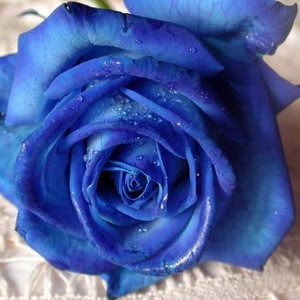
Ahhh, the blue rose. Often talked about but seldom seen. There is only one true blue rose, and it was developed using gene replacement techniques (see picture above). Those roses are very rare. Most roses that are called blue are either sort of a purplish color, or are stem-dyed.
In fact, flowers often have to be dyed in order to get a specific color or to return their original color after they are dried. Frankly, there are times when you need a specific color of flower and it just isn’t available. While spray paint is sometimes an option, stem-dying produces some unique, and often superior results.
Whether the target color is blue, green, purple or magenta, the best color of flower to start with is white because it is more reliable in its results, but other colors work as well. Here is a nice summary of stem-dying from a floral art website called preservedgardens.com. Special coloring for flowers by Design Master or Koch are the best dyes (contact your local florist—like Visser’s or floral supply house) but food coloring may also be used.
Start the process by cutting the flower stems at least 1 inch from the bottom. Remove the lower leaves from the stem. Use the freshest flowers possible because it takes a couple of days for the color to pick up. Mix the dye with warm water and add a little flower food like Floralife. Put the flowers in the water. The color will start to change at the edge of the petal and then move inward. In addition, the leaves and stems will change colors also. After a couple of days, you will have beautiful artificial colored roses that are unique and fun.
In fact, flowers often have to be dyed in order to get a specific color or to return their original color after they are dried. Frankly, there are times when you need a specific color of flower and it just isn’t available. While spray paint is sometimes an option, stem-dying produces some unique, and often superior results.
Whether the target color is blue, green, purple or magenta, the best color of flower to start with is white because it is more reliable in its results, but other colors work as well. Here is a nice summary of stem-dying from a floral art website called preservedgardens.com. Special coloring for flowers by Design Master or Koch are the best dyes (contact your local florist—like Visser’s or floral supply house) but food coloring may also be used.
Start the process by cutting the flower stems at least 1 inch from the bottom. Remove the lower leaves from the stem. Use the freshest flowers possible because it takes a couple of days for the color to pick up. Mix the dye with warm water and add a little flower food like Floralife. Put the flowers in the water. The color will start to change at the edge of the petal and then move inward. In addition, the leaves and stems will change colors also. After a couple of days, you will have beautiful artificial colored roses that are unique and fun.
No comments:
Post a Comment